|
Advantech ITA-1610 Compact System
Rugged, versatile fanless compact system with dual display and dual LAN support brings reliable Windows computing power to projects that require utmost reliability
(by Conrad H. Blickenstorfer; photography by Carol Cotton)
Hundreds of millions of consumers and professionals are replacing their notebooks and desktops with smartphones and tablets, relying on rapidly increasing computing power and connectivity in ever smaller and lighter mobile packages. Is this wholesale move away from more conventional computing systems affecting vertical and industrial markets as well? Yes and no. No, because many intelligent and embedded systems simply do not need to be mobile. Once installed, ATMs, gaming machines, signage systems, kiosks and the like will stay in place. Yes, because smaller size and weight are as welcome in vertical market and industrial systems as anywhere else.
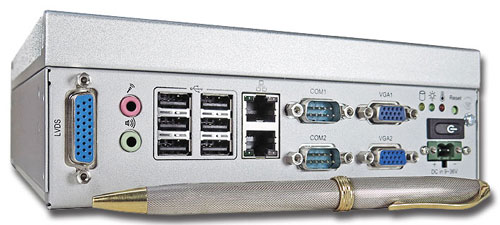
Enter a new breed of small and compact industrial PCs that are only as large as they need to be to accommodate whatever components and systems are required for a job. Embedded systems makers such as Advantech have been making compact, heavy duty fanless PCs for years, but those designs are now getting ever smaller. And example is Advantech's ITA-1000 Series of that specialize in providing maximum reliability and maintainability in small packages with plenty of configurable I/O. These systems form the computing and communications backbone for applications such as Automatic Fare Collection System, Automatic Gate Machines, Ticket Vending Machines, and a wealth of related projects.
As of early 2014, the Advantech ITA-1610 examined in this article is one of four ITA-1000 Series fanless compact systems the company offers. The ITA-1610 Box PC measures 8.7 x 7.5 inches—a footprint a but smaller about as wide but a bit shorter than an iPad—and it's about 2.75 inches tall. Weight is 5.2 pounds (2.36 kg), and most of that comes from the large, finned cooling sink sitting on top of the device.
The ITA-1610, of course, is a full-function PC. It runs Windows Embedded Standard 7 (or also Windows 7 Pro and Windows XP Embedded) on a 1.8GHz Intel Atom D525 dual-core processor. The dual-processor, quad-thread "Pineview" D525 is a mature design first launched by Intel early 2010 for lower-end desktops with a power-conserving (for a desktop) TDP of just 13 watts. As it turned out, desktops turned to Intel's lower end Core processors, but the Pineview D-Series chips eked out a nice market niche in numerous embedded systems applications with predictable performance requirements. And in a design with a large heatsink such as the ITA-1610, D525-based systems do not need rotating fans that can break down and can be hard to replace in deployed embedded systems.
The image below shows the top view and all four side views of the Advantech ITA-1610. The device is dominated by its large, finned aluminium heat sink on top of the system. The 165mm square motherboard is mounted on the inside top of the very sturdy steel enclosure, so that all heat-sensitive components (mostly the chip and chipset) make full contact with the heat sink via strip of heat-conducting material. Note the clean, functional box design and execution that makes it easy to integrate, mount, and service this system.
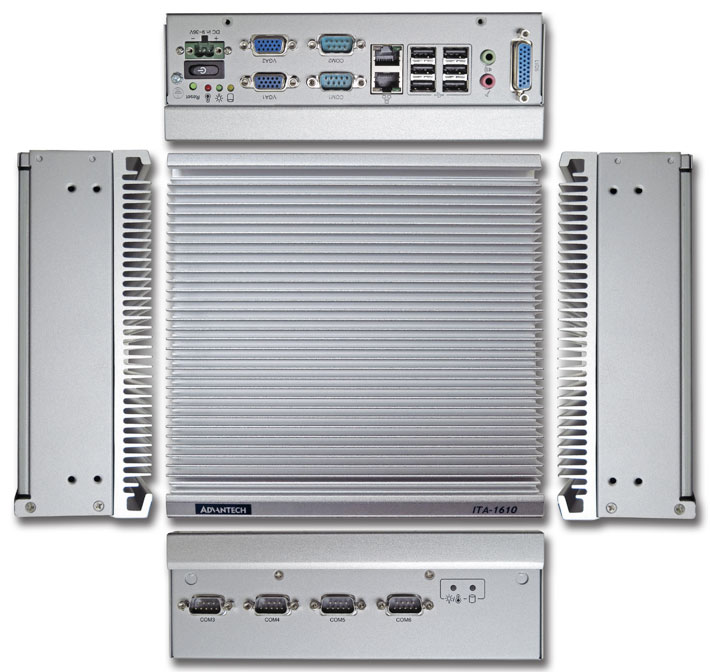
Compared to any consumer or hobbyist desktop, the ITA-1610 device is much simpler, much more rugged, and much more straightforward. Everything is tight and compact, but without being cramped. There's an absolute minimum of wires. The few there are simply connect I/O ports to the motherboard in neatly routed and usually encased wiring.
In terms of functionality and connectivity, this compact computer offers all the I/O generally required for applications the system was designed for. Our review ITA-1610 was configured to offer the following external ports:
- 6 x USB 2.0
- 2 x Serial RS232/422/485
- 4 x Serial RS232
- 2 x RJ-45 gigabit LAN
- 1 x speaker-out with 2 x 4 watt amps
- 1 x microphone-in
- Power (9-36 Volt DC)
- 2 x 15-pin VGA video
- 1 x LVDS
- Audio line-in and line-out
The ITA-1610 is designed to run off either CompactFlash or a SATA 2.5-inch hard disk (or presumably a SATA SSD). Our review unit ran Windows Embedded Standard 7 on a 16GB Advantech industrial grade, extended temperature SQFlash card with software protection and life-monitoring.
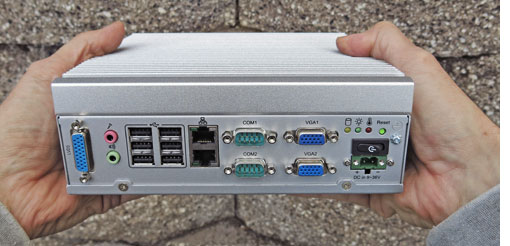 I/O is divided between edge-mount ports on the backside of the ITA-1610, and cable-connected I/O modules on the front. This approach allows Advantech to offer the ITA-1610 in two versions with very different I/O on the front. The ITA-1610-S0A1E Advantech sent us for hands-on review came with the six COM ports shown in the picture above; the also available ITA-1610-00A1E has four digital I/O ports and a PS/2 port on the front, and also offers an LPT port (as used to connect old-fashioned line printers eons ago, but still at times required today). I/O is divided between edge-mount ports on the backside of the ITA-1610, and cable-connected I/O modules on the front. This approach allows Advantech to offer the ITA-1610 in two versions with very different I/O on the front. The ITA-1610-S0A1E Advantech sent us for hands-on review came with the six COM ports shown in the picture above; the also available ITA-1610-00A1E has four digital I/O ports and a PS/2 port on the front, and also offers an LPT port (as used to connect old-fashioned line printers eons ago, but still at times required today).
From a ruggedness standpoint, the primary threats to the needed reliability of embedded devices such as the ITA-1610 are generally temperatures extremes and shock/vibration. Since these are not mobile systems (though they could be used in vehicles), the drop spec and IP rating (sealing against solids and liquids) that in part define the durability of mobile devices are irrelevant. As a result, there's no IP number and no drop spec, and environmental data is limited to a wide operating temperature range (-13 to 140 degrees Fahrenheit for Flash-based systems).
To provide an idea of the relative performance of the ITA-1610, we ran our two standard benchmark suites, PassMark and CrystalMark. For comparison, we're also listing the results of other Intel Atom-based Advantech industrial PCs we have reviewed and benchmarked over the years.
|
Advantech Intel Atom-based Box PC Benchmarks and Comparisons
|
|
PERFORMANCE COMPARISON
|
Advantech
|
Advantech
|
Advantech
|
Advantech
|
Advantech
|
|
Model
|
ITA-1610
|
ARK-1122
|
ARK-DS520
|
ARK-6320
|
ARK-DS303
|
|
Model (click pic for review)
|

|

|

|

|

|
|
Year tested
|
2014
|
2013
|
2012
|
2011
|
2010
|
|
Intel Atom processor
|
D525
|
N2800
|
N455
|
D510
|
N270
|
|
CPU Speed
|
1.8GHz
|
1.86GHz
|
1.66GHz
|
1.66GHz
|
1.60GHz
|
|
OS Software
|
WES7
|
WES7
|
WES7
|
XPE
|
XPE
|
|
Thermal Design Power (TDP)
|
13 watts
|
6.5 watts
|
6.5 watts
|
13 watts
|
2.5 watts
|
|
CPU Mark
|
556.8
|
546.1
|
248.7
|
509.9
|
252.6
|
|
2D Graphics Mark
|
182.7
|
NA
|
71.3
|
171.5
|
158.7
|
|
Memory Mark
|
266.2
|
254.3
|
220.4
|
231.3
|
227.7
|
|
Disk Mark
|
101.8
|
948.2
|
445.9
|
393.9
|
459.4
|
|
3D Graphics Mark
|
106.8
|
57.0
|
169.1
|
95.6
|
77.3
|
|
Overall PassMark
|
257.0
|
389.7
|
226.3
|
293.8
|
232.6
|
|
CM ALU
|
12,214
|
11,474
|
6,296
|
10,829
|
5,409
|
|
CM FPU
|
10,276
|
9,003
|
4,033
|
9,272
|
4,671
|
|
CM MEM
|
8,649
|
8,757
|
6,033
|
6,527
|
4,223
|
|
CM HDD
|
5,381
|
25,739
|
7,827
|
8,576
|
8,221
|
|
CM GDI
|
2,798
|
1,271
|
2,302
|
2,370
|
2,158
|
|
CM D2D
|
3,481
|
370
|
2,936
|
3,899
|
2,230
|
|
CM OGL
|
787
|
8,016
|
5,183
|
709
|
684
|
|
Overall CrystalMark
|
43,586
|
64,630
|
34,610
|
42,182
|
27,596
|
The usual qualifiers apply here: even within closely related processor brands and families, benchmark results often yield confusing numbers (especially in graphics) and it often feels like comparing apples and oranges. In our experience of benchmarking many hundreds of rugged mobile and industrial computing devices, however, we've found that the overall bottomline numbers generally provide a good measure of actual perceived performance.
With the above in mind, we noted that the dual-core Atom D525-based ITA-1610 offers significantly more punch than some of the early-generation Atom designs. It doesn't come close to Core processor performance, but then it wasn't designed for that, and apps the ITA-1601 will be used for won't need it.
That said, do note that the type of storage technology used in these systems has an almost disproportionally large impact on overall bottom line performance. Often, the type of solid state storage can make significantly more of a difference to overall performance than the processor itself. The CF Flash used in our review unit did not generate great benchmark numbers. This may or may not matter, and CF Flash does have its own inherent advantages, but alternate storage technologies would most likely result in a very significant increase in overall benchmark numbers.
Like many Advantech embedded products, the ITA-1610 includes SUSIAccess software, a remote management API that can be used to monitor, configure, and control terminals in a centralized, real-time maintenance system. Our review system also included Advantech's Booting Manager, EWF (Enhanced Write Filter) Manager, and a FBWF (File Based Write Manager) utility.
As is, the two available configurations of the ITA-1610 provide an economical, compact full Windows computing platform that can be used for various intelligent embedded system projects with its dual display capability, flexible storage options, peripheral and machine interface operations with its multiple legacy ports, or data transmission gateway with its dual LAN ports and PCIe expansion slot. And that's just the beginning of its potential.
-- Conrad H. Blickenstorfer
Advantech ITA-1610 Compact System Specs:
| Status |
Added 01/2014
|
| Type |
Compact System Box IPC
|
| CPU Type |
1.8GHz Intel Atom D525
|
| Chipset |
Intel ICH8-M
|
| BIOS |
AMI SPI 16 Mbit
|
| OS |
Windows Embedded Standard 7, Windows 7 Professional
|
| Memory |
1GB or 2GB DDR3 1066MHz in 1 204-pin SODIMM socket |
| Graphics Controller |
Embedded Gen3.5+GFX (400 MHz) |
| Watchdog Timer |
255-level timer intervals, software setup |
| Graphics Interface |
2 x VGA or VGA + LVDS (single channel up to 2048 x 1536 pixel, dual channel max 1366 x 768), dual independent displays |
| LAN |
2 x 10/100/1000 Mbps (Intel 82583V) LAN RJ45 |
| Storage |
1 x CompactFlash, SAT HDD support
|
| Housing |
Steel case, aluminum heat sink, with optional DIN-rail, VESA and/or other mounts
|
| Vibration |
Unknown
|
| Shock |
Unknown
|
| EMC |
Unknown
|
| Safety |
Unknown
|
| Operating temperature |
With HD: 32° to 104°F (0° to °40C)
w/o HD: -13° to 140°F (-25° to °60C)
|
| USB |
6 x USB 2.0
|
| Serial |
2 x RS232/422/485, 4 x RS232 serial |
| Audio |
1 x speaker-out, 1 x mic-in |
| Communication |
Optional via Mini PCIe |
| DIO |
1 x 8-channel GPIO |
| Size |
8.7 x 7.5 x 2.75 inches (220 x 190 x 70 mm)
|
| Weight |
5.2 pounds (2.36 kg) |
| Power |
9-36VDC via adapter
|
| Price |
Inquire |
| Webpage |
Advantech ITA-1610 page |
| Datasheet |
Advantech ITA-1610 |
Advantech Corporation
13 Whatney
Irvine, CA 92618
Toll Free: 1-800-866-6008
Ph: 949-420-2500
Fax: 949-420-2501
ECGInfo@advantech.com
www.advantech.com
Advantech Co. Ltd.
No.1, Alley 20, Lane 26, Rueiguang Road
Neihu District, Taipei Taiwan 114, R.O.C.
Tel: 886-2-2792-7818
Fax: 886-2-2794-7301
www.advantech.com
|



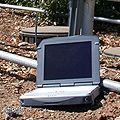


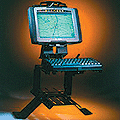







 I/O is divided between edge-mount ports on the backside of the ITA-1610, and cable-connected I/O modules on the front. This approach allows Advantech to offer the ITA-1610 in two versions with very different I/O on the front. The ITA-1610-S0A1E Advantech sent us for hands-on review came with the six COM ports shown in the picture above; the also available ITA-1610-00A1E has four digital I/O ports and a PS/2 port on the front, and also offers an LPT port (as used to connect old-fashioned line printers eons ago, but still at times required today).
I/O is divided between edge-mount ports on the backside of the ITA-1610, and cable-connected I/O modules on the front. This approach allows Advantech to offer the ITA-1610 in two versions with very different I/O on the front. The ITA-1610-S0A1E Advantech sent us for hands-on review came with the six COM ports shown in the picture above; the also available ITA-1610-00A1E has four digital I/O ports and a PS/2 port on the front, and also offers an LPT port (as used to connect old-fashioned line printers eons ago, but still at times required today).




